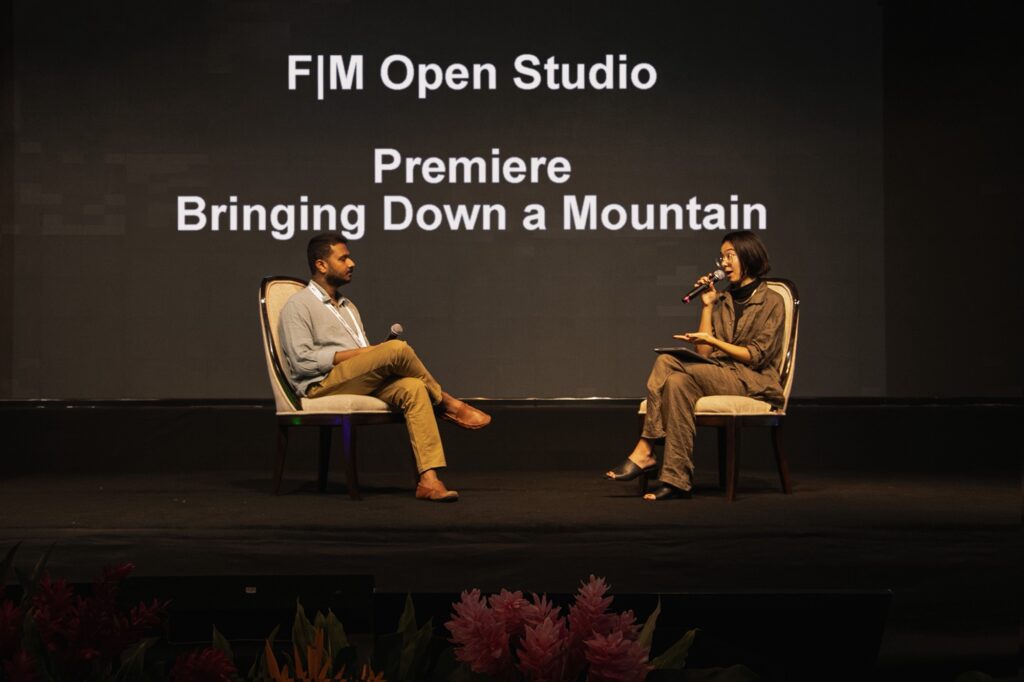
Docufiction Film Bringing Down a Mountain Edited with DaVinci Resolve Studio
Fremont, CA, USA – Friday, March 15, 2024 – Blackmagic Design today announced that the new docufiction short film “Bringing Down a Mountain” was edited and color graded with DaVinci Resolve Studio. DaVinci Neural Engine powered AI tools helped speed up the post production process, with only three weeks available for the edit.
“Bringing Down a Mountain” is the latest short film from Toronto, ON based researcher and filmmaker Subhashish Panigrahi. A departure from his previous documentarian work, “Bringing Down a Mountain” is a docufiction project that’s centered around financial inclusion with a push and pull between caste abolition and internet access.
According to Panigrahi, who served as the film’s director and editor, “‘Bringing Down a Mountain’ is a speculative film in the Odia language set in a city in India where everything and everyone is superior, including the internet. However, a tall mountain surrounds a rural village, stopping the internet and everything online. With the film, we wanted to reimagine what community based and community led technology development would look like. It’s about digital and financial inclusion and reimagining how technology is built and implemented today.”
Since becoming a National Geographic Explorer in 2017, Panigrahi has dedicated his filmmaking career to documenting endangered languages. He has made 10 films capturing disappearing dialects, including the Kusunda language of Nepal that was only spoken by two elderly sisters at the time and is now being revived.
With language as an interwoven fabric in all his projects, Panigrahi credited DaVinci Resolve Studio’s user friendly subtitle generator and AI speech to text transcription feature as being game changers. For “Bringing Down a Mountain,” Panigrahi used the auto subtitle feature to transcribe the audio automatically into a subtitle track on the editing timeline, which he could then further modify. “Since my films are in different languages, I often translate them into English, and then it becomes easier to translate into other languages for international audiences. DaVinci Resolve Studio makes it so easy,” he explained. “Nowadays everyone has to create subtitles for accessibility, so regardless of the project’s native language, it’s a major plus.”
Panigrahi noted that while editing “Bringing Down a Mountain” he enjoyed having the software’s Fairlight features built into the editing process. “While the mix was separate from the edit, I enjoyed having the audio compression and filters built in while I cut. They’re very easy to use and helpful when balancing the audio at the end before exporting,” he said.
“I’ve also found it easier to lock the video and audio files together with DaVinci Resolve. In the past when using another NLE, audio and video synching was always a challenge. I would think I was done with editing and then notice there was an audio and video mismatch. This hasn’t happened since I switched to DaVinci Resolve,” Panigrahi noted. “Having everything together in one software is really a robust approach to post. While I don’t do a lot of VFX work during my editing, it’s a good asset to have when needed, with the Fusion page also at my fingertips.”
After initially using DaVinci Resolve for two films, Panigrahi upgraded to DaVinci Resolve Studio for “Bringing Down a Mountain.” “I originally made the switch to DaVinci Resolve because I was editing the documentary ‘The Volunteer Archivists’ that was shot in very low light conditions, and I kept running into roadblocks with my previous NLE. I never looked back and then wanted to explore even more with this project in DaVinci Resolve Studio,” he explained. “I loved the magic mask features. With the DaVinci Neural Engine in the Studio version, it’s so much easier to automatically match the moving portions of a video using the intuitive object mask. The shot match feature also saved me a ton of time when grading.”
Along with noting that DaVinci Resolve Studio’s speed and rendering power are major assets, Panigrahi added that its portability has been key. “A lot of people edit on the go, myself included. Regardless of if I’m traveling or working from a café, DaVinci Resolve Studio performs beautifully. I was able to edit without getting my charger, and didn’t have to worry about my battery dying,” concluded Panigrahi. “This is especially important for projects like ‘Bringing Down a Mountain’ where I have to create something really fast to meet a festival deadline. With the film premiering in Costa Rica in November 2023, I only had three weeks to finish the edit, and I wouldn’t have been able to do that without DaVinci Resolve Studio.”
Press Photography
Product photos of DaVinci Resolve, DaVinci Resolve Studio and all other Blackmagic Design products are available at www.blackmagicdesign.com/media/images
About Blackmagic Design
Blackmagic Design creates the world’s highest quality video editing products, digital film cameras, color correctors, video converters, video monitoring, routers, live production switchers, disk recorders, waveform monitors and real time film scanners for the feature film, post production and television broadcast industries. Blackmagic Design’s DeckLink capture cards launched a revolution in quality and affordability in post production, while the company’s Emmy™ award winning DaVinci color correction products have dominated the television and film industry since 1984. Blackmagic Design continues ground breaking innovations including 6G-SDI and 12G-SDI products and stereoscopic 3D and Ultra HD workflows. Founded by world leading post production editors and engineers, Blackmagic Design has offices in the USA, UK, Japan, Singapore and Australia. For more information, please go to www.blackmagicdesign.com